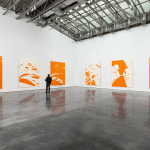When distinguished Baltimore artist and museum board member Amalie Rothschild died in 2001 at the age of 85, she left behind more than 1,200 paintings, sculptures and drawings in her studio. In the Baltimore Sun Glenn McNatt reports that soon after her death, the artist’s daughter and namesake, filmmaker-photographer Amalie Rothschild, decided to honor her mother’s achievement with a coffee-table book documenting her best work, to be published later this year. Rothschild moved the contents of her mother’s studio to a storage facility, and began compiling a detailed list of titles and dates. She soon realized that the whereabouts of hundreds of pieces remained unknown. “My mother kept all her records on 3-by-5-inch index cards in a little recipe box,” Rothschild says. “No addresses, no phone numbers. So I’ve been going through all her scrapbooks, all her exhibition lists and every piece of documentary evidence I’ve been able to find in order to track these things down.”
According to scholar Tom Haulck, much of Rothschild’s work from 1933 to 1966 is figurative, autobiographical in content and influenced stylistically by Cubism, Surrealism and Abstract Expressionism. Between 1948 and 1950 she began to paint geometric abstractions of representational subjects, and in 1951 created her first non-representational abstraction. In the Sixties, Rothschild explored hard-edged abstraction, and began creating sculptural objects as well as paintings. Her work, frequently self-referential and informed by early feminism, addressed the tension between her roles as wife, mother and artist. If anyone has information about works by Amalie Rothschild, please send a note to rothschild_artworks@live.com.






















